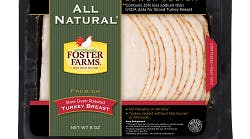To keep pace with competitors and stay ahead in the food and beverage industry, food companies need to know what consumers want − and don't want − and give it to them or remove it quickly. This can be easier said than done, especially when more ingredients are becoming "unwanted" by consumers.
Last year, Panera Bread issued a list of 150 artificial ingredients it is removing from its bakery/cafe menus. This hasn't been easy, especially because there are 465 different ingredients, CEO Ron Shaich said at the time. "But I want to serve food that's clean, serve food I feel good about my daughters eating."
Papa John's International also has a list of unwanted ingredients, as does Whole Foods and others. In March, Schwan Food Co., Bloomington, Minn., announced it was eliminating four ingredient groups including artificial trans fats/partially hydrogenated oils, dyes, artificial flavors and high-fructose corn syrup (HFCS). "We are eliminating these over the next two years and will continue to evaluate our ingredient lists to ensure we are satisfying consumer expectations," says Schwan's CEO Dimitrios Smyrnios.
We've decided to take a look at five controversial substances. The further down our list you read, the more the "science" questioning them becomes dubious. What is unquestionable is that at least some consumers, especially the very vocal ones, want them removed from their foods and drinks.
1. Brominated vegetable oil (BVO)
First patented as a flame-retardant chemical, brominated vegetable oil (BVO) is a complex mixture of plant-derived triglycerides that are reacted to contain atoms of the element bromine bonded to the molecules. The stabilizer has for decades been added to about 10 percent of the soft drinks in the U.S. to keep fat-soluble citrus flavors suspended in soft drinks, giving the drink a cloudy look.
Public pressure is forcing Coca-Cola and PepsiCo to remove BVO from their beverages. PepsiCo is removing it from Gatorade, replacing it with sucrose acetate isobutyrate, but leaving it in Mountain Dew and Amp. Banned in Japan and Europe, BVO has reportedly made some soda-drinkers sick enough to require medical attention for skin lesions, memory loss and nerve problems related to overexposure of bromine. Bromine buildup in body tissues can result in iodine deficiency and bromine toxicity, according to Doctor's Data Inc., a U.K. specialist in toxic chemical testing. The buildup may have the same effects as brominated flame retardants.
Research in animals as well as some human studies found links to impaired neurological development, reduced fertility, early onset of puberty and altered thyroid hormones. Food chemists at Germany's University of Hohenheim suggest American soda makers could easily replace BVO with hydrocolloids, though those may not provide the exact same functionality and could be more expensive.
2. BHA, BHT
Butylated hydroxyanisole (BHA) and its cousin butylated hydroxytoluene (BHT) are both synthetic preservatives that inhibit oxidation and rancidity in many foods and extend shelf life. Research shows they form potentially cancer-causing reactive compounds in the body, however. The International Agency for Research on Cancer, part of the World Health Organization, considers BHA to be possibly carcinogenic to humans, and the state of California has listed it as a known carcinogen.
Yet most research on these oxidants has been with animals and test tubes, not people. At high doses, BHT has been shown to cause cancer in rats, mice and hamsters, but does this exclusively in the animals' forestomach − an organ humans don't have. In the low levels used in food preservatives, many researchers consider BHT safe, given our lack of forestomachs.
The FDA categorizes BHA and BHT as generally recognized as safe (GRAS) for their intended use in specified amounts. Subsequent reviews supported their general safety, but concluded that "uncertainties exist, requiring additional studies be conducted." BHA is approved for use in various foods up to 200 parts per million of the fat or oil content of the food product with a couple exceptions. Dry foods like cereal have set limits for each food type (see 21 CFR, Vol. 3).
Nonetheless, Papa John's got rid of the duo in its pizzas. Many breakfast cereals contain a dash of BHT to inhibit vegetable oils from going rancid, although it's more commonly added to the plastic liner. But in February, Kellogg said it was "actively testing natural alternatives" to BHT in cereal packaging liners, and General Mills said it was "already well down the path of removing it," after being urged by consumers and health advocates to drop it.
"This change is not for safety reasons, but because we think consumers will embrace it," General Mills said in a February 2015 statement. "We’ve heard BHT has kept some people from eating cereal, so we’re removing it because we want more people to be able to enjoy our cereals." Cheerios, Trix, Kix and Lucky Charms sold in the U.S. contain no BHT. Cheerios products instead rely on mixed tocopherols (vitamin E), to keep them fresh. Other natural antioxidants include ascorbic acid, vitamin A and spice extracts like rosemary and thyme can be effective. The disadvantage to adding vitamin E is that products might have shorter shelf lives.
3. Nitrites and nitrates
Cured meats by definition must include sodium nitrite, so bacon without nitrates or nitrites is defined as uncured. Bacon is usually cured in a mixture of salt and water, and sodium nitrite is added as a preservative.
Too much sodium nitrite can cause methemoglobinemia, which is when red blood cells cannot transport oxygen throughout the body. In the 1970s, researchers discovered when meat containing sodium nitrites is heated above 266 degrees F, it creates nitrosamines, which the American Cancer Society says are carcinogenic. Limits are now set on the amount of nitrites that can be added to cured meats, and all products containing nitrites must include vitamin C, which prevents the formation of nitrosamines.
Regulations now require 550 ppm (parts per million) of either vitamin C or E to be added to pumped bacon, which greatly reduces the amount of free nitrites and minimizes the formation of nitrosamines. While the USDA prohibits sodium nitrites from exceeding 200 ppm going into dry-cured bacon, sodium nitrites cannot exceed 120 ppm for both pumped and immersion-cured bacon.
The World Health Organization in 2010 listed ingested nitrates and nitrites as probable human carcinogens, and last year upgraded its assessment that processed and red meats can cause cancer, no matter what preservatives have been added to them.
Natural alternatives are sparking demand for preservative-free meat options, which is why more meat packages proudly display "nitrate-free" and "nitrite-free" claims. Lower-cost salt brines made from water, sea salt and vinegar can cure meats for at least six days without refrigeration or any special equipment. Uncured bacon uses natural nitrates found in celery powder or juice and sea salt, which can enhance taste without the use of harmful chemicals.
4. Aspartame
It won FDA approval in 1981 for use as a tabletop (packaged) sweetener and breakfast cereals, powdered beverage mixes and other dry packaged foods. Two years later, the FDA approved it for use in soft drinks, by far its biggest and most lucrative market.
A chemical combination of two amino acids and methanol, aspartame is 200 times sweeter than sugar. The daily recommended dose is 40mg for every kg of body weight, which translates to about 12 cans of diet soda for the average person.
Ingested aspartame breaks down in the stomach into a source of phenylalanine, an essential amino acid that in healthy people has no harmful effects, but should be avoided by those with a genetic disorder called phenylketonuria (PKU). The FDA says eating foods containing aspartic acid has no known adverse health effects and the USDA's 2007 epidemiological studies on aspartame and subsequent evaluations concluded there was no evidence to link aspartame and cancer, and that aspartame is safe in moderate doses.
Yet, last year the sweetener got quite a beating on the Internet. As a result, late in the year, PepsiCo switched its diet cola drinks (Diet Pepsi, etc.) to sucralose, although stating it wasn't doing so because of any indication that aspartame is unsafe. "Aspartame is the number-one reason consumers are dropping diet soda," said Seth Kaufman, vice president of Pepsi in an article at the time. "Diet cola drinkers in the U.S. wanted aspartame-free Diet Pepsi, and we're delivering."
General Mills also dropped aspartame in Yoplait Light yogurt after hearing requests to remove it. "This is something we’ve been considering and looking into for a while," said Steve Young, vice president of Yoplait.
When consumers speak, food and beverage companies listen … sometimes. Even when there is no little or no science behind consumer concerns.
That's apparently also the case with …
5. High-fructose corn syrup
A full-calorie sweetener, high-fructose corn syrup (HFCS) is found everywhere in processed foods, from ketchup and cereals to crackers and salad dressings. HFCS is half fructose and half glucose − the same as table sugar. It's made by a chemical acid hydrolysis process in which corn starch is separated from the corn kernel, and the corn starch is then converted into corn syrup through acid hydrolysis.
The American Medical Assn. concluded last June there's no sufficient evidence saying HFCS is less healthy than other types of sugar: "High-fructose corn syrup does not appear to contribute more to obesity than other caloric sweeteners." Corroborating this is an August 2015 Mayo Clinic article showing insufficient evidence that HFCS is any less healthy than other types of sweeteners.
However, controversy still exists about whether the body handles HFCS differently than table sugar. The real culprit is the fructose; some studies in animals and humans suggest fructose may not satisfy hunger the same way glucose does, leading to overeating. But since HFCS' proportions of fructose and glucose are about the same as table sugar, it's no better and no worse for you than sugar. It's just the victim of a poorly chosen name.
With some fanfare, ConAgra replaced it with sugar in Hunt's ketchup in 2010 … and quietly switched back to HFCS two years later. The removal of HFCS did nothing for sales.
"We're replacing HFCS with liquid sugar and in some instances, using dextrose to help with browning," says Karen Wilder, senior director of Schwan Foods' health & wellness department. "The initiative is part of our longtime work to evolve our foods to meet the health and wellness expectations of consumers and customers. We're removing HFCS because some of our consumers and customers said they wanted to avoid it."
Natural nutritive sweeteners like honey, tapioca syrup, brown rice, oat and other grain syrups, as well as pear and apple sweeteners can replace HFCS, though it may not be easy. HFCS is versatile, convenient and inexpensive. Experts say knowing the properties of HFCS and how it interacts with other ingredients is key to figuring out how to replace it.


